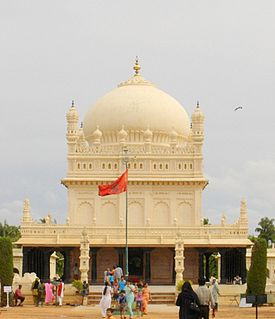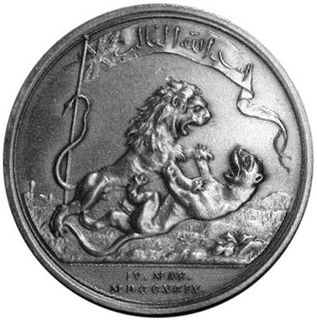 W
WSrirangapatna is a town of Mandya district in the Indian State of Karnataka. Located near the city of Mysore, it is of religious, cultural and historic importance.
 W
WHyder Ali, Haidarālī was the Sultan and de facto ruler of the Kingdom of Mysore in southern India. Born as Hyder Ali Khan, he distinguished himself militarily, eventually drawing the attention of Mysore's rulers. Rising to the post of Dalavayi (commander-in-chief) to Krishnaraja Wodeyar II, he came to dominate the titular monarch and the Mysore government. He became the de facto ruler of Mysore as Sarvadhikari by 1761. He offered strong resistance against the military advances of the British East India Company during the First and Second Anglo–Mysore Wars, and he was the innovator of military use of the iron-cased Mysorean rockets. He also significantly developed Mysore's economy.
 W
WDaria Daulat Bagh is a palace situated in the city of Srirangapatna, near Mysore in southern India. It is mostly made out of teakwood.
 W
WThe Gumbaz at Srirangapatna is a Muslim mausoleum at the centre of a landscaped garden, holding the graves of Tippu Sultan, his father Hyder Ali, and his mother Fakhr-Un-Nisa. It was built by Tippu Sultan to house the graves of his parents. The British allowed Tippu to be buried here after his death in the Siege of Srirangapatna in 1799.
 W
WMasjid-i-Ala is a mosque located inside the Srirangapatna Fort in Srirangapatna in Mandya District in Karnataka. It was built during the regime of Tipu Sultan during 1786-87. The mosque is located close to the Bangalore Gate and has two minarets. The mosque is built over an elevated platform.
 W
WPurnaiah (Purniya), aka Krishnacharya Purniya or Mir Miran Purniya was an Indian Administrator and statesman and the 1st Diwan of Mysore Kingdom. He has a rare distinction of governing under three kings, Hyder Ali, Tipu Sultan and Krishnaraja Wadiyar III. He governed the Mysore kingdom from 1782 to 1811. He was known for his skill with accounts, prodigious memory and proficiency in several languages. He was also a wartime military commander while serving under Tipu Sultan. After Tipu Sultan's defeat, Mummadi Krishnaraja Wodeyar was educated and trained by Purniah from 1799 till 1810, he governed the Kingdom of Mysore together with the English resident of the East India Company.
 W
WThe Ranganthaswamy temple in Srirangapatna, in the Mandya district of Karnataka state, India, is dedicated to the Hindu god Ranganatha. It is one of the five important pilgrimage sites of Sri Vaishnavism along the river Kaveri for devotees of Ranganatha. These five sacred sites are together known as Pancharanga Kshetrams in Southern India. Since Srirangapatna is the first temple starting from upstream, the deity is known as Adi Ranga. The town of Srirangapatna, which derives its name from the temple, is located on an island in the river Kaveri.
 W
WRanganathittu Bird Sanctuary, is a bird sanctuary in the Mandya District of the state of Karnataka in India. It is the largest bird sanctuary in the state, 40 acres (16 ha) in area, and comprises six islets on the banks of the Kaveri river.
 W
WGarrison Cemetery is located in Seringapatam, on the banks of the river Cauvery, about 300m from the Bangalore Mysore Highway. It has about 307 graves of the European officers killed in the final assault on Tippu Sultan in 1799, and their family members. Among the graves, there are 80 graves of the officers of the Swiss ‘de Meuron Regiment’, and the rest of the graves are their family members.
 W
WDistrict - Mandya
 W
WThe Scott's Bungalow is located in Seringapatam on the banks of the river Cauvery, at about half a mile from the Mysore Gate of the Seringapatam gate. The bungalow was the residence of Col. Scott, an officer of the Madras Army who took part in the Siege of Seringapatam in 1799. The bungalow is associated with the legend and tradegy of Col. Scott. The story of Scott's Bungalow is lamented in a poem by Walter Yeldham called The Deserted Bungalow, published in 1875.
 W
WThe Seringapatam Medal, or Sri Ranga Pattana, is a campaign medal that was awarded by the Governor-General of India to all British and Indian soldiers who participated in the British victory in the Battle of Seringapatam in 1799.
 W
WThe 1792 Siege of Seringapatam was a battle and siege of the Mysorean capital city of Seringapatam (Srirangapatna) at the end of the Third Anglo-Mysore War. An army led by Charles, Earl Cornwallis consisting of British East India Company and British Army forces, along with allied forces from the Maratha Empire and the Nizam of Hyderabad, arrived at Seringapatam on 5 February 1792, and after less than three weeks of battle and siege, forced Tipu Sultan to capitulate. With his agreement to the Treaty of Seringapatam on 18 March 1792, the war came to an end.
 W
WThe Siege of Seringapatam was the final confrontation of the Fourth Anglo-Mysore War between the British East India Company and the Kingdom of Mysore. The British, with the allied Nizam of Hyderabad and Maratha, achieved a decisive victory after breaching the walls of the fortress at Seringapatam and storming the citadel. Tipu Sultan, Mysore's ruler, was killed in the action. The British restored the Wodeyar dynasty to the throne after the victory, but retained indirect control of the kingdom. The leader of the British troops was Major General David Baird.
 W
WSrirangapatna Fort is a historical fort located in Srirangapatna, the historical capital city in the South Indian state of Karnataka. Built by the Timmanna Nayaka in 1454. The fort was fully fortified and the architecture was modified with the help of French architects to meet the growing needs of saving against invaders. The river Kaveri surrounds the fort in one of the sides. The fort is protected in the West and Northern directions by river Cauvery. The fort had Lal Mahal and Tipu's palace, which were demolished during the British capture of 1799. There are seven outlets and two dungeons.
 W
WTipu Sultan, also known as Tipu Sahab or the Tiger of Mysore, was the ruler of the Kingdom of Mysore based in South India and a pioneer of rocket artillery. He introduced a number of administrative innovations during his rule, including a new coinage system and calendar, and a new land revenue system which initiated the growth of the Mysore silk industry. He expanded the iron-cased Mysorean rockets and commissioned the military manual Fathul Mujahidin. He deployed the rockets against advances of British forces and their allies during the Anglo-Mysore Wars, including the Battle of Pollilur and Siege of Seringapatam. He also embarked on an ambitious economic development program that established Mysore as a major economic power, with some of the world's highest real wages and living standards in the late 18th century.